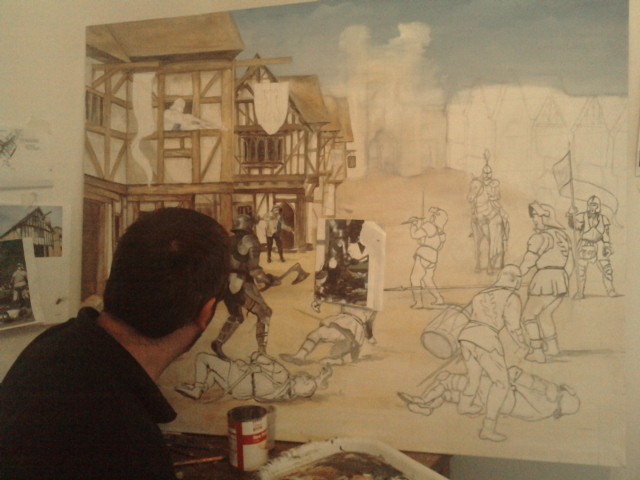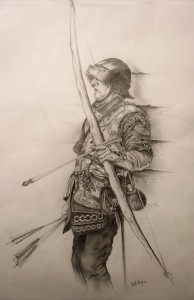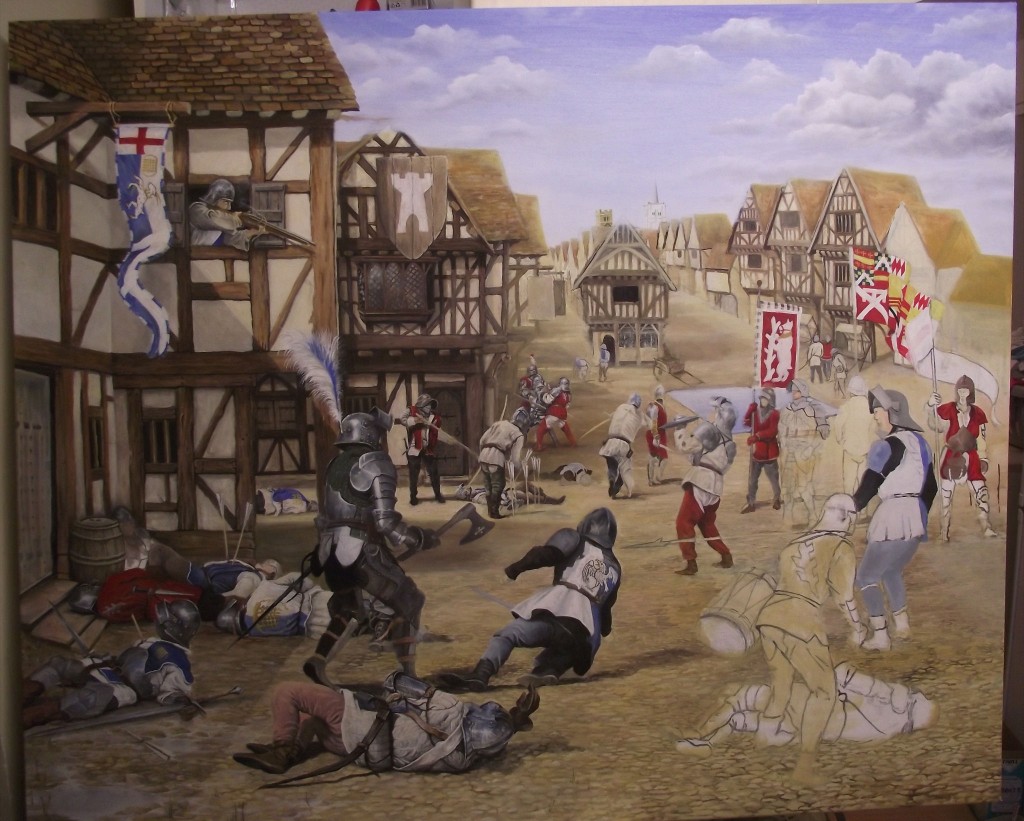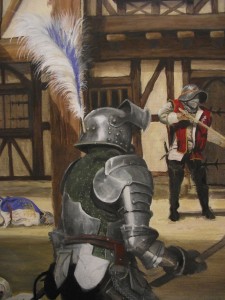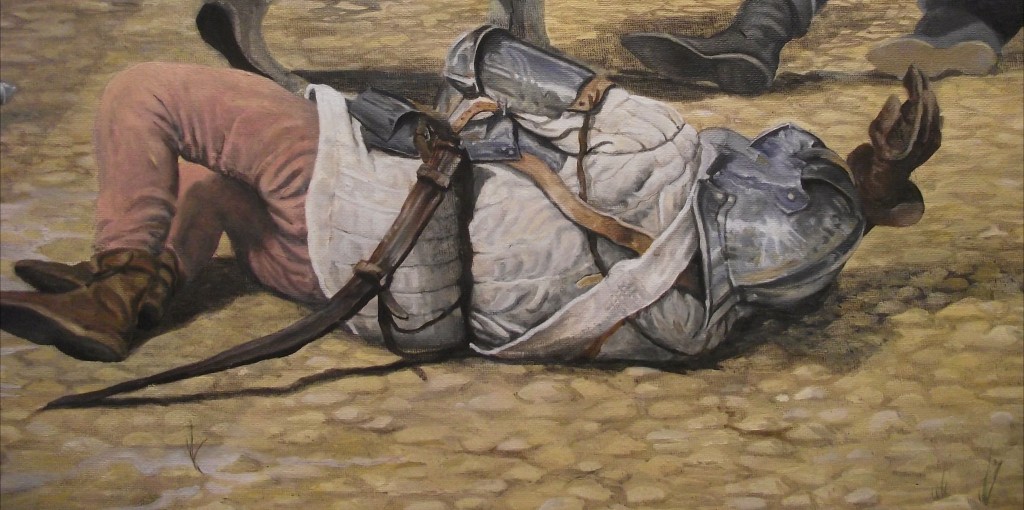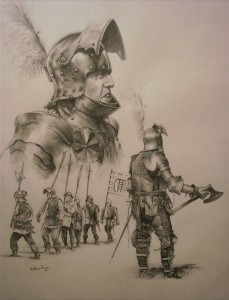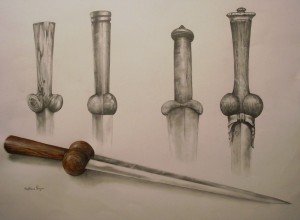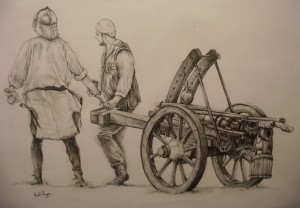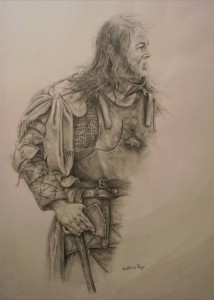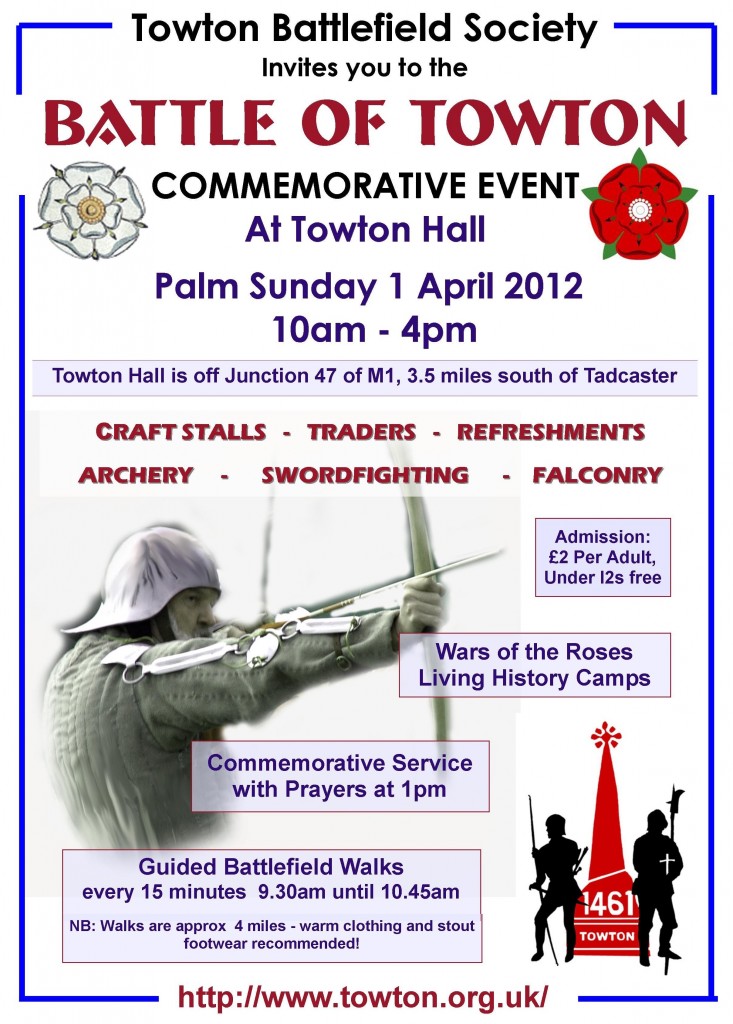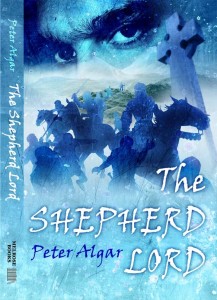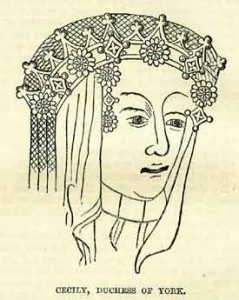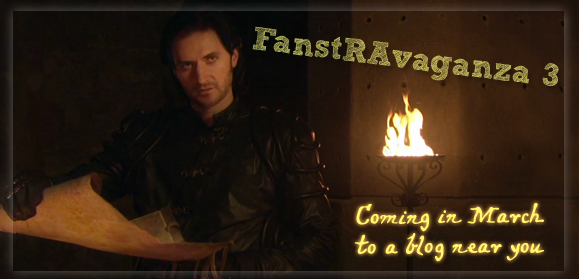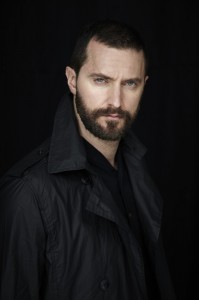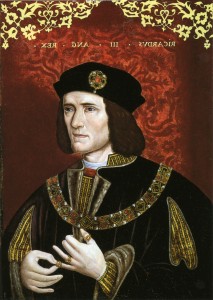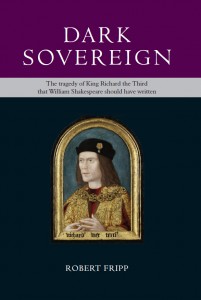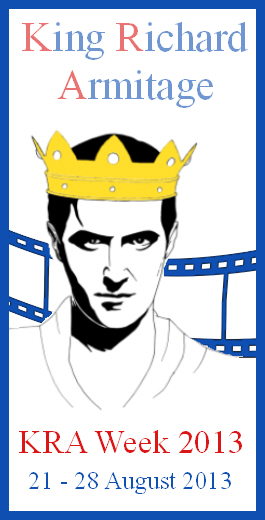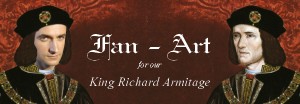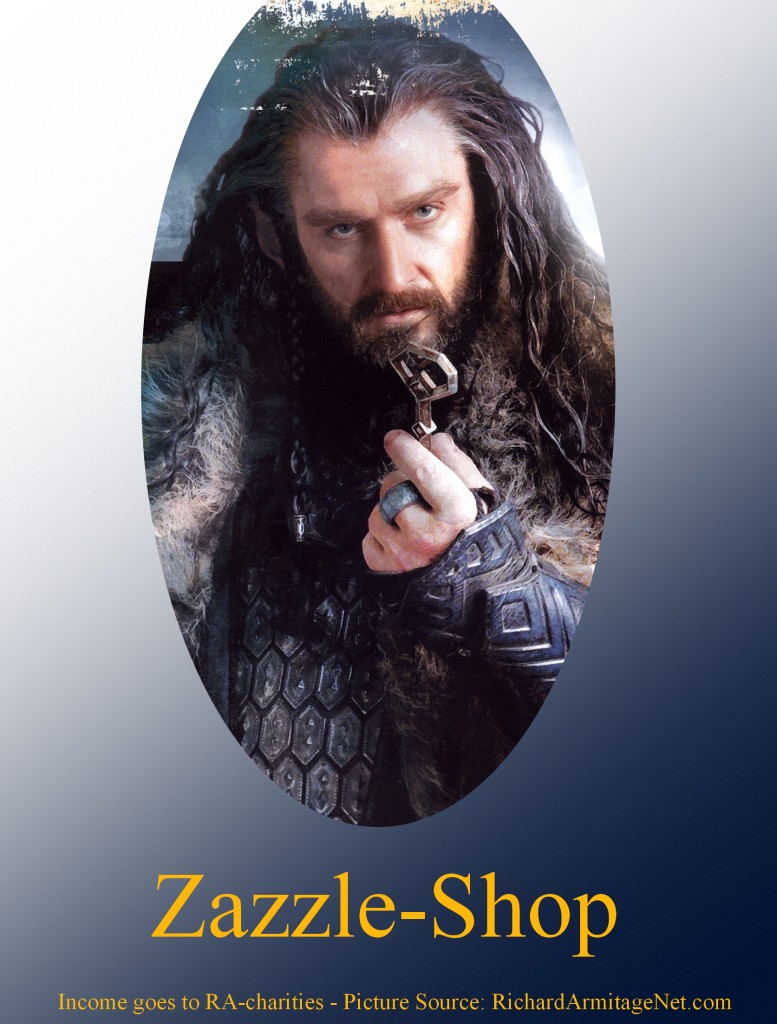Matthew Ryan and the Illustration of King Richard III’s time
I don’t promise too much, when I announce our next interview guest as the man who really makes history visible.
How is that possible, you will likely ask, but with extensive research and lifelong exercise and even archery training as background, Mr. Matthew Ryan as well has the experience as the talent to bring the time of King Richard back in full colour.
Here now our interview with Historical Illustrator
Matthew Ryan
Thank you for joining us today and sharing your wonderful artwork with us.
What especially interests us is, how did you come to do historical illustrations?
I have always drawn and painted for as long as I can remember and as a boy most of my pictures were of knights and battles (though not very historically accurate back then). I loved the work of John Howe and Alan Lee [KRA-Comment: Those two artists will especially interest all Tolkien- and “The Hobbit” fans.] and was also very inspired as a child by the Illustrations of Knights by Julek Heller.
After leaving School I studied for a H.N.D. in Visual Communications and also did a Degree in Illustration. I then worked for eleven years as a traditional signwriter/advertiser and although I enjoyed my work it was not what I wanted to be doing.
All this time however I was reading history books and visiting places of historic interest. History has always been a passion of mine especially the medieval period.
I have also shot Longbows for most of my life and for the past few years Warbows, I took much inspiration from reading books by people such as Hugh Soar
, Robert Hardy
and Anne Curry
and also seeing how people like Simon Stanley, Mark Stretton and Steve Stratton draw back the heavy bows. I find that making and shooting my own arrows gives me a small but real connection to the thoughts and ideas of our ancestors and is a good indirect inspiration to my work.
All these influences took me to where I am today and I put my two greatest passions together, art and history and now work as an historical Illustrator. I now find the pictures that I am producing are a lot more productive because I am illustrating something that I am passionate about.
What methods of painting / drawing do you like best or prefer to use?
I love working with most materials but my favourite is oil paint, as this really lets me put a lot of depth and detail into my work. I also like working in just pencil and enjoy the simple nature of that medium.
What are your favourite topics for your paintings?
I am inspired by painting big and fantastic events from the past featuring kings and people of note but I also love to portray the common person in quieter pictures and try to give an insight into the day to day life of people of that time. Emotion is something I love to get into my pictures so I try to show that in my work and I think it helps to bring the pictures to life.
What is your favourite historic timeframe and why is that so?
Because of my love of archery it has to be the Hundred Years War but visually I enjoy the style of armour and clothing from the times of The Wars of the Roses and am fascinated by the drama of this period.
Here on KingRichardArmitage, with all the historical interest showing up around Mr. Armitage’s mentioning of King Richard III, we are naturally curious, where you get your sources and material for your artwork. How do you research details about a certain time to depict in your illustrations?
I research in many different ways depending on what I am painting. I try to base much of what I do on contemporary illustrations although this in its self can be fraught with many problems. For details of armour I find viewing carvings on tombs and going to museums very useful and I also visit various re-enactments. Often research and reading takes more of my time than the painting, but the more information and answers I have on a subject the easier the painting is to produce. Speaking to historians is of course a great help and my thanks go out to those who have already given me help and direction.
Mr. Ryan, you gave us wonderful examples of your work to post together with your interview here on KingRichardArmitage. Where can we find further information about you and your creations?
I do not yet have my own website but people are welcome to view my work on my Facebook page at…
matthewryanhistoricalillustrator @facebook.com
and I can be contacted at…
matthewryanhistoricalillustrator@LIVE.CO.UK
You let us know, that your next main project will be about King Richard III and the Battle of Bosworth. Why Bosworth and what interests you in King Richard III and his time?
Many things fascinate me about the Battle of Bosworth and King Richard, it is something I hope to base much of my future work on. I find it very inspiring that a King will put himself in mortal danger by leading from the front and fighting amongst his enemies.
I enjoy illustrating historic themes that history may have misinterpreted or unjustly portrayed in the past and Richard III certainly in my opinion fits this bracket.
Your paintings are no mere depictions of a time, but tell a whole and colourful story about fate and life on their own. So let me ask, what is your intention with your artwork about King Richard III and by giving colour to a time long past?
I wish to produce a painting that honours the memory of our last Plantagenet King, the last King to die on the field of battle and a King that has no tomb as a final resting place. I hope when complete the picture does him some justice and may serve as an inspiration for others to find out more about him.
An inspiration your artwork indeed is and it is a joy to discover your creations, which so well revive the past. I hope you will keep us updated on your project about King Richard III and the Battle of Bosworth. We love to hear and see more about your wonderful and well researched painting projects.
Thank you very much for the interview and taking the time to talk with us, Mr. Ryan.
The link to Mr. Ryan’s picture galery on Facebook:
To get in contact with Mr. Ryan:
matthewryanhistoricalillustrator@LIVE.CO.UK
Further News about King Richard III:
Maria Grazia (Fly High!)- Interview & Giveaway with Cecilia Latella about Richard III
Maria Grazia posted an interview with artist Cecilia Latella about her comic book “The Boar“, depicting the life and fate of King Richard III. Cecilia Latella speaks about her way to King Richard III and has some very interesting reading tips for new and advanced King Richard fans.
Leave a comment at her blog post till March 5th, 2012 to enter the giveaway contest for either a free Italian (print book) or an English (e-book) version of the comic book “The Boar” by Cecilia Latella.
The Towton Battlefield Society Supports King Richard III
We added a new Supporter page to our website, a page dedicated to the Towton Battlefield Society.
For years or even centuries, the importance of this battle lay forgotten. A group of dedicated people came together in the year 1993 to revive the memory and preserve the area, where the fate of England was decided on Palm Sunday in the year 1461.
A holy day saw the blodiest battle, England ever suffered. Estimations are that about 27,000 men died in this battle between the Lancastrian and Yorkist fractions.
To commemorate this fiercely fought battle, the Towton Battlefield Society has an event on Palm Sunday each year and kindly sent us the announcement and description of this event.
Britain’s Biggest Battle Bears Testimony to Those Who Will Never Forget
This Palm Sunday, 1st April marks the commemoration of Britain’s bloodiest encounter, the Battle of Towton, fought on 29th March, 1461 during the Wars of The Roses.
The event will be recognised by Towton Battlefield Society who have, since 1993, tirelessly worked for the battlefield’s protection and acknowledgement as a place of national significance. The battle, which was preceded by two major skirmishes at Ferrybridge and Dintingdale, raged all day in blizzard conditions until the Lancastrians were routed, many drowning in Cock Beck. Towton was a climactic battle between the houses of York and Lancaster; chivalry was dead and the order went out for no quarter to be given. The Lancastrian king, Henry VI was not skilled in battle and spent the time at York Minster, devoting his prayers to a victory, leaving the proud and haughty Duke of Somerset to lead his army. The commander of the Yorkist faction and self-proclaimed King of England, the nineteen year old Edward IV, was a natural leader though, and inspired his men on a tortuous forced march from London to meet their implacable foes. Outnumbered and exhausted the Yorkists were hard-pressed and on the brink of collapse when reinforcements were led onto the field by the Duke of Norfolk and victory was now within Edward’s grasp. You will be able to see the route the fleeing Lancastrians took on Palm Sunday as guided walks are planned every 15 minutes from 9:30 to 10:45 a.m.
TBS are a registered charity, aided entirely by volunteer help. Their objectives are to preserve the integrity of the battlefield, educate the public and promote research into the battle and related medieval history. In the early days very few members of the public knew about the dramatic events at Towton but now, scarcely a week goes by without an article being published in the Press or the battle getting a mention on TV programmes.
TBS Chairman Mark Taylor said, “We have a real extravaganza in store this year. This is recognised by many medieval re-enactors as the place to be and we have an action-packed agenda including archery, sword-fighting and falconry. Our Patron, the actor Robert Hardy, will also be putting in an appearance and we are being supported by Welcome to Yorkshire, who realise what a boost our attraction is to tourism in the area. Nonetheless, conscious of the current pinch on the public’s purse strings, we are pitching the entry fee at only £2.00 per person so that families can have a great but inexpensive day out.”
Gary Verity, Chief Executive of Welcome to Yorkshire, said: “We are delighted to be involved with this event, which attracted more than 3,000 visitors last year. We’re looking forward to it being a great success once more.”
So, at £2.00 entrance fee, free car parking and a full day’s agenda with something to please everyone in the family, this event is not one to be missed. Turn up at Towton Hall on Palm Sunday, 1st April, for a warm Yorkshire welcome.
George Peter Algar – The Shepherd Lord
One’s death the other’s fortune?
You will ask, what we mean with that subtitle. But that is exactly the fateful combination between the “Shepherd Lord” and King Richard III. King Richard’s death leads to the change in the ‘Shepherd Lord’s’ fortune.
The Shepherd Lord is son to John Clifford, the 9th earl, an enemy of King Richard III and his family, who is said to have personally killed King Richard III’s brother Edmund, the Earl of Rutland, after the battle of Wakefield, where also King Richard III’s father died in the year 1460.
The Shepherd Lord’s father once again fought for the Lancastrian side against King Edward IV in the battle of Towton on Palm Sunday of the year 1461, where he is defeated and killed. This leads to the hiding of the son Henry, to assure his safety. After the end of the Plantagenet’s reign, Henry Clifford was able to come back into his power, rightful inheritance and family name and he became the 10th Earl after his father.
I can console you, King Richard, as always, cannot be seen as complete and total enemy and bad guy in these bloody events. He intervened in favour of “The Shepherd Lord’s” family, while his brother Edward IV’s was still king, and once again takes an ambivalent position, which remains for us to chose, do we see him as totally bad or through and through good person. King Richard III rarely allows us to see him in a mediocre way, but rather black and white, depending on one’s perspective.
Though King Richard III only plays a background figure in the events of this story, the book sheds more light on the intrigues and family interests of this time and the gripping story of “The Shepherd Lord” is a worthy recommendation in its own right.
David Santiuste interviewed author and researcher Mr. Algar for Historytimes.com and kindly let us re-publish his interview. (Please follow the link to the full interview):
Interview with George Peter Algar about “The Shepherd Lord”
The basis for the story about Henry Clifford and the first literary mentioning of the ‘Shepherd Lord’ is William Wordsworth’s poem
“Song at the Feast of Brougham Castle”
of the year 1807,
which we link in here via The Project Gutenberg, to give you a further appetizer for the book about “The Shepherd Lord”. The re-print of the poem by Project Gutenberg also contains further annotations of the author William Wordsworth about the historical background, which are interesting to read as well.
Author’s website: The Shepherd Lord
Author’s blog: GeorgeAlgar.com
The Role of a King or Why Richard III is so Intriguing
I agree with historian Dr. Ashdown-Hill (Interview / some of his research publications) that the question ‘if’ King Richard III killed his nephews cannot be the main focus of historical research, as it is not even certain that they were indeed killed.
Furthermore, there are quite some other parties in the political scenery of the time occupying themselves with intrigues and plots. Most of them had as much or more reason to get rid of the heirs of King Edward IV’s or at least abduct them to get them under their own custody.
- King Richard III’s mother, Cecily Neville, who did not like her daughter-in-law, Elizabeth Woodville and plotted against her eldest living son Edward IV during his reign and afterwards, to beware a succession of his ‘illegitimate’ children. She even went so far as to declare Edward IV himself as illegitimate, not because of the ‘adultery’ she sometimes was accused of, but because of his being born in Rouen. Some sources even go so far as to see her as the leading instigator of the discovery of the first marriage of King Edward IV, leading to the succession of King Richard III.
- Henry Tudor, the known Lancastrian opponent and enemy of Richard III, who wanted to prevent a Yorkist ascension to the throne and might have wanted a pawn against King Richard III.
- Nobles from the ‘South’, observing that Richard III supported Northerners in offices formerly entirely held by representatives of the South.
- Richard III’s sister-in-law, Elizabeth Woodville and her large family, fearing that King Richard III might not adequately support their now ‘illegitimate’ members of the royal family.
- Members of the administration, guards, nobility, etc. , trying to get a reward for their ‘helping’ in the matter.
- Illnesses, as only 1 out of 5 children survived into adulthood during that time. For boys the chances to survive were even slightly less than for girls. If one remembers, that even appendicitis was a likely cause to die, the likeliness that the princes died in the Tower must remain a valid option as well, though there is the fact of a missing burial.
- Even Richard III could have transferred or hidden the princes himself to get them out of the shooting line of all these intrigues around them and to leave them space to grow up.
You see there were so many parties with a large interest in getting rid of the princes, that it would have been a wonder if Richard III got to them first and that without leaving a clear trail of his deed.
What one can accuse Richard III of is, that he did not take better care of them or provide for them so that they could be abducted, murdered or have died under his custody. But as not even the cause of their disappearance is clear, to cast accusations is a bit premature.
As it is, King Richard III could not even prevent the death of his own son. Interesting in my opinion would be, what his own son died of and if that illness could have spread. On the continent for example, ‘Schweißfieber’ spread and caused many deaths at that time.
What also is an interesting aspect in the matter is, why King Richard III’s wife did not get another child. Was it because of a hard delivery of her first child or other causes? This indeed makes her a likely recipient of the jewellery found near Middleham castle. Maria Grazia (interview with her here) just published a lovely article about it on her blog Fly High!
But enough of speculation for now. King Richard III suffered enough speculation, during his lifetime and certainly afterwards.
Though, one of the fascinating aspects of his story for me is, that it leaves so much to speculate and still, in all of this, one cannot determine his character entirely.
Preview:
King Richard Armitage currently prepares an interview with an author, who researched his family history and found an interesting story taking place during King Richard’s time. We hope to present this article to you next Wednesday.
FanstRAvaganza 3 is coming in March 2012
FanstRAvaganza-banner created by the fan-artist and blogger bccmee.
FanstRAvaganza
A very special fan-event for, about and around the actor Richard Armitage is coming in March 2012.
That Mr. Armitage has an army behind him, an accomplishment even our highly valued King Richard III had some difficulties with, is no secret. Some reporters are (or should I say, most reporters can’t refrain from) teasing the actor about it.
That the fandom of Mr. Armitage does not only say
‘A‘ for army, but also
‘B‘ for blogs,
is not so widely known.
The well founded and far spread support Richard Armitage has online, becomes evident in the wide ‘bloggo-sphere’, where people talk and discuss his roles, his career, his acting and all kinds of news around this actor, like now, the upcoming film of “The Hobbit” by Sir Peter Jackson.
That blogging is not only a singular business consisting of monologues, but a discussion and network of friends and a helpful and connected, not only committed community, some bloggers around the founder of the event, Nat (Richard Armitage Fan Blog), showed already two years ago with the first FanstRAvaganza event in the year 2010.
Servetus, the blogger responsible for the naming of the event, wants to excuse the long name, but it in my opinion is exquisite, consisting of the key elements of the Richard Armitage (for insiders RA) fandom:
Fans (the key element),
extra (for extraordinary),
extravagant (for a very special moment in time),
RA (for the reason of everything).
So what better name could this event possibly have?
The third and so far ‘biggest’ event will handle the growing interest in Mr. Armitage and the increasing number of blogs, by organising the event in a new way:
It will consist of 8 anchor bloggers (posting every day of the 1 week of FanstRAvaganza),
and a team of tagged bloggers around them (posting single posts or not daily).
More details can be found in this article by Servetus, who will kindly organise the participation for the event.
The KingRichardArmitage website will take part in this FanstRAvaganza event, as Mr. Armitage is the reason, that this website and the petition movement for a filming project around King Richard III exists.
More details will follow closer to the event, which starts Monday, 12th of March, 2012.
We hope you will enjoy our contributions and the FanstRAvaganza event surrounding it.
Information about the event and articles will be available at:
Facebook page: FanstRAvaganza
Twitter account: FanstRAvaganza
Twitter Hashtag: #FanstRA
A website is also built right now to collect all the article links: FanstRAvaganza website
Contributions of last year’s event: FanstRAvaganza 2011
Maria Grazia of Fly High and King Richard III
The reason why you are our guest today, Maria Grazia, is that your main blog, FLY HIGH!
features pages dedicated to Richard III and to Richard Armitage. You’ve been writing about RA’s career and work for a while now and you’ve started an interesting series focused on Richard III and his history – with posts written by you and by experts – recently (Link list follows below the interview!). You seem to be keen on both Richard III and Richard Armitage, hence, you are the ideal guest for this site. Welcome!
Thanks for inviting me. You are right I have got a real interest in both the men. I really hope Richard Armitage will achieve his dream of shooting/producing a TV series about Richard III and that it could contribute to the spreading of a new, more positive image of the wrongly despised King of England.
What was it that brought you to want to know more about King Richard III, who in literature mostly got a description of being an ugly, hunchbacked and crippled King?
I owe my enthusiasm for the Ricardian cause and my extraordinary quest in search for the real Richard III to a novel: Sharon Kay Penman’s The Sunne in Splendour. It was such a revelation for someone like me who had always and only read Shakespeare’s tragic portrait of him as the ultimate villain. An incredibly powerful characterization but so distant from the reality, I bet.
After that novel, I’ve read other interesting ones based on a completely positive image of Richard III: Josephine Tey, The Daughter of Time and Anne O’Brien’s The Virgin Queen.
The ugly monster who killed his nephews to get to the throne was substituted by the very humane figure of a complex, loyal, dutiful man.
Was the fascination more because of the image you had because of Shakespeare or were other factors more important?
I’ve never been so interested in Shakespeare‘s Richard III, actually. His historical plays are the ones I know and appreciate the least. I prefer tragedies like Hamlet, Macbeth, Romeo and Juliet, Othello or comedies like The Merchant of Venice, Much Ado about Nothing, Twelfth Night or As you like it. Smart dramatist and wonderfully gifted writer as Shakespeare was, he fully achieved his aim with the Tudor propaganda: fiction replaced history and it has gone on like that for centuries. Richard Plantagenet has been Shakespeare’s hunchbacked and crippled king for so many and for so long. But now I’m fascinated by the contrast between the documents discovered later on – with the resulting new hypothesis – and Shakespeare’s account of those facts.
Can you share a very special fan-event / moment determining your interest in King Richard with us?
Well, as you may guess, everything started when I heard Richard Armitage talk about his Richard III project. I had been following his career for a while after watching him as John Thornton in North and South, when I happened to watch an interview for the promotion of Robin Hood season 2, in which he talked about a different image of Richard III in a script he was working on. I was struck by lightning: “Richard III was not wicked?!? What is this all about”?
So I started researching and I discovered The Ricardian Society and their cause.[Annotation: More information and contact details of the Richard III Society in this article and page on KRA.]
I’ve listened and read more of Richard Armitage about Richard III (the interview in the Venetia audiobook, an interview for Strike Back on the radio and , especially the interview at Vulpex Libris) until I decided to buy and read The Sunne in Splendour and … I got in love with Sharon Kay Penman’s Dickon. Now, I can’t actually see Richard Armitage (an adult man) as young Dickon, but I would love to see him as Richard III in the last years of his life.
What is a special aspect / character trait of King Richard III which fascinates you?
His being loyal to his brother, King Edward IV, to his duties as Duke of Gloucester and Lord of the North, to his family. Then, the picture I have in my mind is biased by the romantic Dickon Ms Penman portrayed, of course, but I can only imagine him as a very sensitive and thoughtful husband and father. Just have a look at his concerned look in his portrait: that can’t be the look of a wicked person.
Did you see some of the places where King Richard lived, stayed, was?
Oh indeed I did! And it was memorable. I went to Yorkshire in July and the best moment of the Ricardian tour was our visit to Middleham Castle. It was so thrilling, even moving. I was touched and sad during that visit. The place was bleak and windy. I so wanted to have glimpses of the happy moments Richard had lived there, but it was not easy. Then I was at Sheriff Hutton and at Bosworth. I wrote about that experience on Fly High and you can see also some of my pictures in “On the Footsteps of Richard III”.
What about you and … Richard Armitage?
Richard Armitage is my favourite actor and my “one weakness“. Everything started in August 2008 when I decided to buy a DVD online titled NORTH AND SOUTH (BBC 2004). I wanted to use it in my lessons about Mrs Gaskell and her novels. It was the end of my old serious prof-style life and the beginning of a half – serious addiction to everything this man happens to do. And he has surprised me in many ways so far: he was young Monet (one of my favourite painters!), wicked Lovelace in Richardson’s Clarissa, a handsome workaholic doctor in The Golden Hour, evil Gisborne in Robin Hood, tender John Standring in Sparkhouse, dashing treacherous John Mulligan in Moving On, lovely Harry J. Kennedy in The Vicar of Dibley, but last and definitely not least, he miraculously landed on my favourite BBC series, SPOOKS as Lucas North. I know this list is not complete but these are just the first roles which came to my mind in no particular order. I’m glad he’s going to be under global spotlight as Thorin Oakenshield in The Hobbit and would eagerly like him as King Richard III.
Do your family / friends / colleagues share your admiration for King Richard III?
I’ve got few friends who share my interest in Richard III but no colleague or member of my family, unfortunately. However, thanks to my blog I’ve had the chance to meet other admirers from all over the world!
Maria Grazia lives in Italy, not far from Rome. She teaches English as a foreign language to teenage students and English literature and she loves her job. She became a blogger to help her students and support them with useful materials in 2008 and blogging has become her main hobby. Fly High is her main site about books, art, period drama, movies, classic literature, historical fiction and Richard Armitage. She’s also got a Jane Austen-dedicated page, My Jane Austen Book Club, where she “meets” Janeites to discuss everything Austen. She’s married and has two teenage sons.
Maria Grazia and her articles about King Richard III on FLY HIGH:
Maria Grazia online:
- Twitter – SmaryG
- Facebook –Fly High
- Facebook – My Jane Austen Book Club
- Maria Grazia on paperblog
Why Would King Richard Ride on a Badger? – Or Rather a Hog?
If you read our last post, you perhaps wondered, why in the “Horrible History” video about Shakespeare’s version of King Richard, he would choose a badger instead of a horse to ride away from the battlefield at Bosworth.
By chance, I found a reference, which perhaps is quite well known for all English readers here, but for me was totally new.
The text brings King Richard III in connection with quite a few animals:
Sir William Collingbourne (1435 – 1484) wrote the following verse:
The Rat, the Cat and Lovell the Dog,
Rule all England under the hog.
(Original note, pinned to the door of St. Pauls Cathedral on 18 July, 1484:
the Catte, the Ratte and Lovell our dogge
rulyth all Englande under a hogge.)
The poet got executed because of this ‘offensive’ couplet. Why, is not immediately understandable for us now, when the “Horrible History” episode could bring in a badger, without causing any offence, but perhaps just a slight rising of the eyebrow in astonishment.
The for people of King Richard’s time well understandable connection and irony becomes clear, when we exchange the animals with the dignitaries, Collingbourne intended with those names:
Rat = royal adviser Sir Richard Ratcliff
Cat = minister Sir William Catesby (Chancellor of the Exchequer during King Richard’s reign)
Dog = Viscount Lovel (His family’s heraldic symbol was the wolf)
Hog = King Richard III (King Richard III’s banner animal, the boar, is re-interpreted and made into a tame hog.
Collingbourne got his place in history for this small witticism, as the one who got executed for the least cause, as Tudor author Edward Hall puts it.
That Collingbourne indeed meant to offend King Richard III with his verses, becomes clear when one has a closer look at the hinted meaning in his witticism.
The boar, the chosen banner animal of King Richard, in Medieval times was an animal which was treated with greatest admiration, either for its strength, endurance, intelligence and fierce way as a fighter during hunts as well as its uncompromising care for its offsprings. It was greatly feared and hunters did not approach a boar on their own, but only dared to hunt a boar in larger groups and still it was deemed one of the most dangerous animals to hunt and brought the hunter who killed one greatest admiration.
To change that into a tame animal, which was by far not as highly valued for its attributes, though it was a useful creature, was a clear offense of its own, which mostly evades ouf perception of the case today, where most of us never came close to either a hog or a boar.
Collingbourne not only attacked the king, but also his three closest confidants, who all three profited greatly from their connection to Richard III during his reign, but who also loyally supported him and died for their king at or shortly after the Battle of Bosworth.
But closer research into the case reveals more than just a witticism.
Collingbourne had been part of a bigger conspiracy in favour of Henry Tudor, which was stopped and he, as leader of the conspiracy, consequently was executed in the year 1484. He had ‘published’ more than one witticism on the door of St. Pauls Cathedral and was famous for his short notes criticising the King and his confidants. He also stood in direct correspondence with Henry Tudor, encouraging him to land at Poole to forcibly take the crown from King Richard III, as indeed Henry Turdor later did at Bosworth.
(The badger, deriving from a mentioning in the “Black Adder” depiction of King Richard III, is perhaps comparable to a boar in size. At the time of King Richard III it would have been even more offensive than a hog, as it is a rather easy to hunt animal, though normally one would not want to do that at all, as the meat of badgers, except of very young ones or in early spring, is of no use, because the intensive odour of the fat makes it nearly unedible. That it also hides in holes in the earth would have increased the unsuitability of that animal to bring in connection with a king.)
Resources:
Wikipedia is an invaluable source and even solved the error, my printed source (therefore not named, as it is wrong in that case) held, by naming the culprit and author of the verses not Collingbourne, but Collingham.
Some articles of interest are:
Article is loosly refering to Grimm’s Encyclopedic collections (German invaluable sources of all symbolism and hidden meaning behind signs and images of any kind, though the brothers are better known for their fairy tales.)
Important notice to all signers of the petition:
We have currently accumulated over
60 unconfirmed signatures
of the petition (which are not included in our signatures count in the sidebar!).
We fear, this high number might be due to the delivery of the mail into your spam-folder, as the confirmation mails contain a return-link to co-ordinate the feedback.
To all unconfirmed signers, we will send out the confirmation mail again tomorrow (19th of January, 2012). Please check your e-mail and eventually your spam-folder.
Thank you !
Shakespeare – What he Should Have Written …
Shakespeare’s “Richard III” is well or mostly not so well remembered from school.
It is common knowledge that Shakespeare was very creative with forming historical detail anew to reach the greatest effect for his plays, so he cannot be seen as a reliable source for the times of King Richard III.
That even King Richard III himself has strong objections against Shakespeare’s version of the story, shows this funny little video by “Horrible Histories”:
But the endeavor to write, what Shakespeare should have written if he had been more true to real events, nobody undertook before
Robert Fripp
Robert Fripp and his work “Dark Sovereign” are presented in an article by Maria Grazia on her blog Fly High!.
The book can be ordered via Amazon and is available in print and as Kindle version.
Amazon.com
Amazon.ca
Amazon.co.uk (Affiliation link)
Amazon.de (Affiliation link)
(As far as possible, we link to affiliate programs and the income goes to charities supported by Mr. Armitage. Please also consider the affiliation links at RichardArmitageNet.com for Amazon U.S. and U.K., where the income also goes to RA’s charities.)
Merry Christmas and Happy Holidays
Dear readers and supporters of King Richard and Richard Armitage,
Alfie did a wonderful fan-art especially for Christmas and I just need to post it here on this blog as well:
(Preview of the picture here. For full view, please follow this link or click on the picture to reach Alfie’s blog post with the larger picture.)
After seeing that picture, there can not possibly be any doubt left. Mr. Armitage just is the true King Richard III.
Merry Christmas and have wonderful, relaxed and enjoyable holidays!
P.S.: We will be back with book recommendations and authors’ interviews after Christmas, so spare some of your book vouchers you get as Christmas presents!
Book-Recommendations
In the last weeks, we have been presenting diverse artists to you, which specialised in pictures, animations, paintings, scrapbooking and drawings.
We also got contributions in form of
texts and books.
To present those adequately, especially at a time, where everybody is preparing for Christmas and is choosing presents for loved ones, we decided to do book presentations, to give you the one or other tip or hint for a present or your own reading list.
We already had interviews with wonderful authors and researchers like Prue Batten, Isolde Martyn and Dr. Ashdown-Hill. We will include their publications in our presentations and hope you will enjoy our recommendations and find them useful and an enrichment for your reading list.
We encourage you to use the buying options with Amazon.com and Amazon.co.uk offered by
where income from the affiliation is donated to Mr. Armitage’s recommended charities.
The embedded links here either go to links of the authors, their publishers or our affiliate programs with Amazon.co.uk / Amazon.de and are intended to give you access to further information regarding the presented and reviewed books. Should income be generated, it will be donated to charities recommended by Mr. Armitage.
More book presentations and reviews will follow in the next days. To give you a preview and first tips of interesting books regarding the topic of our heart, please see the following selections:
King Richard III in Historical Research
Fiction
For a full list of our reviews and recommended materials, please visit our Richard Resources and Products pages. (Will be updated and extended on a regular basis.)
We wish you a nice and relaxed pre-Christmas time and happy preparations!
